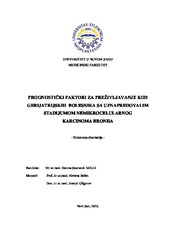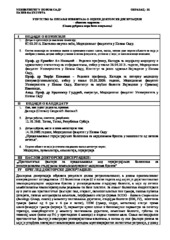Приказ основних података о дисертацији
Prognostički faktori za preživljavanje kod gerijatrijskih bolesnika sa uznapredovalim stadijumom nemikrocelularnog karcinoma bronha
Prognostic factors for survival in geriatric patients with advanced stage of non-small cell lung cancer
| dc.contributor.advisor | Sečen, Nevena | |
| dc.contributor.advisor | Gligorov, Joseph | |
| dc.contributor.other | Považan, Đorđe | |
| dc.contributor.other | Andrijević, Ilija | |
| dc.contributor.other | Džodić, Radan | |
| dc.contributor.other | Gudurić, Branimir | |
| dc.contributor.other | Ač-Nikolić, Eržebet | |
| dc.creator | Sazdanić-Velikić, Danica | |
| dc.date.accessioned | 2016-10-08T15:47:46Z | |
| dc.date.available | 2016-10-08T15:47:46Z | |
| dc.date.available | 2020-07-03T13:29:03Z | |
| dc.date.issued | 2016-09-23 | |
| dc.identifier.uri | https://nardus.mpn.gov.rs/handle/123456789/6657 | |
| dc.identifier.uri | http://www.cris.uns.ac.rs/DownloadFileServlet/Disertacija146519332710095.pdf?controlNumber=(BISIS)101147&fileName=146519332710095.pdf&id=5918&source=NaRDuS&language=sr | sr |
| dc.identifier.uri | http://www.cris.uns.ac.rs/record.jsf?recordId=101147&source=NaRDuS&language=sr | sr |
| dc.identifier.uri | http://www.cris.uns.ac.rs/DownloadFileServlet/IzvestajKomisije146519333651630.pdf?controlNumber=(BISIS)101147&fileName=146519333651630.pdf&id=5919&source=NaRDuS&language=sr | sr |
| dc.description.abstract | UVOD: Savremenim dijagnostičkim i terapijskim dostignućima, kao i unapređenjem preventivnih mera produžen je životni vek ljudi. Starenje stanovništva je fenomen koji zahvata ceo svet. Povećanje broja starijeg stanovništva je udruženo sa porastom broja obolelih od karcinoma u ovoj starosnoj grupi, jer je starenje samo po sebi riziko faktor za nastanak karcinoma. Incidenca pojave karcinoma naglo raste od 50-te godine života sa vrhom u 80-toj godini života. U osoba starijih od 65 godina se dijagnostikuje 58% svih karcinoma, a 30% u starijih od 70 godina. Godine starosti nisu kontraindikaciija za sprovođenje hemioterapije kod starih bolesnika sa karcinomom. Starenje je povezano sa izmenjenom farmakodinamikom i farmakokinetikom antitumorskih lekova i povećanom osetljivošću normalnog tkiva na toksične komplikacije, te je odluka kliničara kod davanja hemioterapije ovoj starosnoj kategoriji bolesnika sa karcinomom uvek vrlo kompleksna i zahteva dobru procenu i odgovarajuću selekciju bolesnika za ovaj tretman. MATERIJAL I METODE: Doktorska disertacija obuhvata rezultate delom restrospektivnog, a delom prospektivnog opservacionog istraživanja sprovedenog u periodu 01.01.2011. do 31.12.2013.godine u Institutu za plućne bolesti Vojvodine u Sremskoj Kamenici, u kojem je praćeno 152 bolesnika starosti 65 i više godina kod kojih je dijagnostikovan nemikrocelularni karcinom bronha u uznapredovalom stadijumu bolesti, a koji su lečeni kombinovanim hemioterapijskim režimom na bazi platine. Kao prognostički faktori su uzeti: starosna dob bolesnika (grupa mlađih od 75 godina i starih 75 i više godina), pol, navika pušenja cigareta (pušač, nepušač, bivši pušač), navika konzumiranja alkohola, performans status (prema ECOG-Eastern Cooperative Oncology Group skali) u momentu postavljanja dijagnoze, patohistološki tip tumora (adenokarcinom, skvamozni karcinom, drugo), stadijum bolesti (IIIb, IV), veličina tumora (manje od 6 cm i 6 cm i više), TNM status prema klasifikaciji tumora (7.revizija), parametri krvne slike (vrednosti leukocita, hemoglobina, trombocita), biohemijski parametri (vrednosti laktat-dehidrogenaze (LDH), alkalne fosfataze, aspartat- aminotransferaze (AST), alanin-aminotransferaze (ALT), kalijuma, natrijuma, bilirubina) na početku terapije, komorbiditeti u momentu postavljanja dijagnoze (broj komorbiditeta po sistemima, Charlson index), simptomi bolesti (kašalj, hemoptizije, otežano disanje, bol u grudnom košu, promuklost, smetnje gutanja, sindrom gornje šuplje vene, bol u kostima, simptomi od strane centralnog nervnog sistema, povišena telesna temperatura), gubitak na telesnoj masi (više od 5% u prethodnih 6 meseci), indeks telesne mase (<18,5kg/m² pothranjen, 18,5-24,9kg/m² normalno uhranjen, 25-29,9kg/m² prekomerna telesna masa, ˃30kg/m² gojaznost). Svi potencijalni prognostički faktori su evaluirani univarijantnom analizom, a potom su svi faktori rizika za koje je utvrđena značajnost analizirani primenom multivarijantne logističke regresije, u cilju prepoznavanja nezavisnih prediktora za dvogodišnje preživljavanje. Za otkrivanje nezavisnih prediktora preživljavanja na dve godine je primenjena binarna logistička regresiona analiza, a kao potencijalni prediktori su bile sledeće varijable: starost ispod 75 godina, pušačka navika, patohistološki tip karcinoma, stadijum bolesti IV, T4 status, M1b status, prisustvo respiratornog komorbiditeta, otežano disanje, bol u grudima. Kumulativno preživljavanje je prikazano Kaplan-Meier-ovim krivama. Primenom multivarijantne Cox- regresione analize su dobijeni nezavisni prediktori kumulativnog preživljavanja. Iz dobijenih prognostičkih faktora koji se izdvajaju kao nezavisni prediktori za preživljavanje su kreirani matematički modeli za dvogodišnje preživljavanje. CILJ ISTRAŽIVANJA: Utvrditi uticaj pojedinih prognostičkih faktora na dvogodišnje preživljavanje ovih bolesnika i iz toga izvesti matematički model za stratifikaciju ovih bolesnika u odnosu na dvogodišnje preživljavanje. REZULTATI: Analizom prognostičkih faktora je utvrđeno da grupa bolesnika starih 75 godina i više ima nešto duže dvogodišnje preživljavanje od grupe bolesnika mlađih od 75 godina, ali bez statističke značajnosti, bolesnici sa tumorom veličine 6 cm i više imaju kraće dvogodišnje preživljavanje u odnosu na bolesnike sa tumorom manjim od 6 cm, bolesnici kod kojih je u momentu postavljanja dijagnoze T status tumora bio T4, a M status M1b imaju kraće dvogodišnje preživljavanje, bolesnici kod kojih je na početku tretmana u laboratorijskim nalazima bila prisutna anemija i povišene vrednosti LDH imaju kraće dvogodišnje preživljavanje, prisustvo više komorbiditeta utiče na kraće preživljavanje, bolesnici sa gubitkom na telesnoj masi većim od 5% u periodu 6 meseci pre postavljanja dijagnoze bolesti imaju kraće dvogodišnje preživljavanje. Kreirana su dva matematička modela (jedan za preživljavanje na 2 godine i jedan za kumulativno preživljavanje) za stratifikaciju gerijatrijskih bolesnika sa uznapredovalim stadijumom nemikrocelularnog karcinoma bronha lečenih hemioterapijom na bazi platine u odnosu na dvogodišnje preživljavanje. ZAKLJUČAK: Dobijeni matematički modeli za preživljavanje gerijatrijskih bolesnika sa uznapredovalim stadijumom nemikrocelularnog karcinoma bronha lečenih hemioterapijom na bazi platine na jednostavan način stratifikuju bolesnike u odnosu na preterapijske prognostičke faktore za razliku od sveobuhvatne gerijatrijske procene koja je vremenski zahtevna procedura i zahteva obučen kadar. | sr |
| dc.description.abstract | INTRODUCTION: Nowadays life expectancy is prolonged due to modern diagnostic and therapy achievements, as well as promotion of preventive measurements. Aging of population is a phenomenon in the whole world. Increasing number of elderly population is accompanied with the increased number of diagnosed cancer in this age group, because the aging themselves is a risk factor for development of cancer. The appearance of cancer rapidly rises from the age of fifty with the peak at the age of eighty. 58% of cancer diagnoses are in the people older than sixty-five years and 30% in people older than seventy years. The age is not contraindication for chemotherapy treatment in older patient with cancer. The aging is associated with disturbed pharmacodynamics and pharmacokinetics of antitumor drugs and increased susceptibility of normal tissue for toxic complications, therefore clinical decision for introducing chemotherapy is very complex and requires good assessment and proper selection of the patients for this treatment. MATERIAL AND METHODS: This doctoral thesis includes results of partly retrospective and partly prospective observational research conducted in the period 01.01.2011. until 31.12.2013. at the Institute for pulmonary diseases of Vojvodina in Sremska Kamenica, which includes 152 lung cancer patients 65 and more years old with diagnosed non-small cell lung cancer in advanced stage treated with combined platinum based chemotherapy regimen. These prognostic factors are included: age of patients (group <75 years, group ≥75 years old), sex, smoking cessation (smoker, former smoker, non smoker), alcohol consuming habit, performance status (according to the ECOG-Eastern Cooperative Oncology Group scale) in the moment of confirmed diagnosis, pathohistological type of tumor (adenocarcinoma, squamous cell carcinoma, other), stage of disease (IIIb, IV), tumor size (<6cm and ≥6cm), TNM status according tumor classification (7th revision), blood count parameters (leucocyte, hemoglobin level, thrombocyte), biochemical parameters (lactate-dehydrogenase level (LDH), alkaline phosphatase level, aspartate aminotransferase level (AST), alanine aminotransferase level (ALT), potassium level, sodium level, bilirubin level) on the start of the chemotherapy, comorbidities at the moment of diagnosis (number of comorbid conditions, Charlson index), symptoms of the disease (cough, hemoptysis, dyspnea, chest pain, hoarseness, swallowing difficulties, caval venae compression symptoms, bone pain, central nervous symptoms, increased body temperature), weight loss (˃ 5% in the previous 6 months), body mass index (<18,5kg/m² underweight 18,5-24,9kg/m² normal weight, 25-29,9kg/m² overweight , ˃30kg/m² obese). All potential prognostic factors were evaluated with univariante analysis, and after that all factors with confirmed significance were analysed with multivariante logistic regression, in order to identify independent predictors for 2-year survival. Binary logistic regression analysis was applied for identifying independent predictors for 2-years survival and those variables were analysed : age <75 years, smoking cessation, pathohistological type of cancer, stage of disease IV, T4 status, M1b status, presence of respiratory comorbidity, dyspnea, chest pain. Cumulative survival of those patients was shown with Kaplan-Meier prognostic curves. Two mathematical model for 2-year survival was created from the factors confirmed as independent predictors for survival. AIM: This research objectives were to determine the influence of certain prognostic factors on 2-years survival of those patients and to create mathematical model for stratification of those patients related to 2-years survival. RESULTS: Univariante analysis confirmed that the group of patients older than 75 years and more have had better 2-year survival than group of patient younger than 75 year, but without the statistically significance, patients with tumor size ≥6cm have had worst 2-year survival in comparison with patients with tumor size <6cm, patients with tumor status T4 at the moment of diagnosis and M status M1b have had the shorter 2-year survival, patients with anemia and increased LDH level on the start of the chemotherapy treatment have had shorter 2-year survival, the presence of more comorbid conditions at the moment of diagnosis influence on shorter 2-year survival, patients with weight loss more than 5% in the previous 6 months have had shorter 2-year survival. Two mathematical models were created (one for 2-year survival and the other for the cumulative survival) for stratification of elderly patients with advanced staged non-small cell lung cancer treated with combined platinum based chemotherapy regimen related to 2-year survival. CONSLUSION: Created mathematical models for stratification of elderly patients with advanced staged non-small cell lung cancer treated with combined platinum based chemotherapy regimen more easily stratify patients compared to pretreatment prognostic factors as opposed to comprehensive geriatric assessment which is time-consuming procedure and requires trained personnel. | en |
| dc.language | sr (latin script) | |
| dc.publisher | Универзитет у Новом Саду, Медицински факултет | sr |
| dc.rights | openAccess | en |
| dc.rights.uri | https://creativecommons.org/licenses/by-nc-nd/4.0/ | |
| dc.source | Универзитет у Новом Саду | sr |
| dc.subject | karcinom bronha | sr |
| dc.subject | Carcinoma | en |
| dc.subject | Bronchogenic | en |
| dc.subject | Non-Small-Cell Lung | en |
| dc.subject | nemikrocelularni karcinom pluća | sr |
| dc.subject | prognoza | sr |
| dc.subject | analiza preživljavanja | sr |
| dc.subject | stari | sr |
| dc.subject | antineoplastički protokoli | sr |
| dc.subject | hemioterapija | sr |
| dc.subject | Prognosis | en |
| dc.subject | Survival Analysis | en |
| dc.subject | Aged | en |
| dc.subject | Antineoplastic Protocols | en |
| dc.subject | Drug Therapy | en |
| dc.subject | Carcinoma | en |
| dc.title | Prognostički faktori za preživljavanje kod gerijatrijskih bolesnika sa uznapredovalim stadijumom nemikrocelularnog karcinoma bronha | sr |
| dc.title | Prognostic factors for survival in geriatric patients with advanced stage of non-small cell lung cancer | en |
| dc.type | doctoralThesis | en |
| dc.rights.license | BY-NC-ND | |
| dcterms.abstract | Глигоров, Јосепх; Сечен, Невена; Гудурић, Бранимир; Aч-Николић, Ержебет; Поважан, Ђорђе; Aндријевић, Илија; Джодић, Радан; Сазданић-Великић, Даница; Прогностички фактори за преживљавање код геријатријских болесника са узнапредовалим стадијумом немикроцелуларног карцинома бронха; Прогностички фактори за преживљавање код геријатријских болесника са узнапредовалим стадијумом немикроцелуларног карцинома бронха; | |
| dc.identifier.fulltext | http://nardus.mpn.gov.rs/bitstream/id/35658/Disertacija4736.pdf | |
| dc.identifier.fulltext | http://nardus.mpn.gov.rs/bitstream/id/35659/IzvestajKomisije4736.pdf | |
| dc.identifier.fulltext | https://nardus.mpn.gov.rs/bitstream/id/35659/IzvestajKomisije4736.pdf | |
| dc.identifier.fulltext | https://nardus.mpn.gov.rs/bitstream/id/35658/Disertacija4736.pdf | |
| dc.identifier.rcub | https://hdl.handle.net/21.15107/rcub_nardus_6657 |



